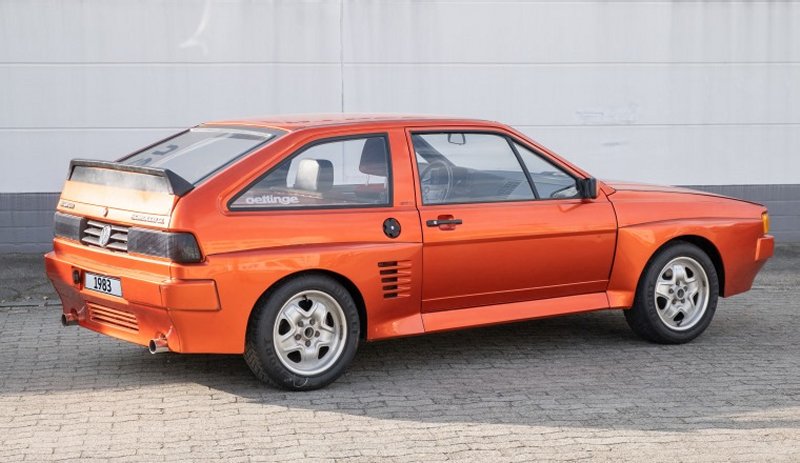280/4



The second Bi-motor Scirocco was created by the VW development department. This incarnation used two 16v engines. Each engine gave a power output of 141 bhp. A special bodykit was grafted onto the car to cater for the Audi Quattro alloy wheels.

The 280/4 was finished to a much higher standard than the 360/4, maybe to try and push for a limited production run which sadly never came to fruition.


280/4 Bi-motor Scirocco on the VW test track at Ehra Lessien, closely followed by the prototype Scirocco Turbo.

If you are as curious as I am, you will be wondering what the decal is at the bottom of the B-pillar. After years of research, I found it to be this.


Strangely, the car wears a Scirocco CL badge. Could it be less like the base model?

View of the front engine showing the Oettinger 16v head.

Rear engine compartment. The grill for the rear radiator is neatly incorporated between the tail lights. The number plate is re-located into the new body kit.

The Oettinger 16v cylinder head.

A rare interior shot of the 280/4.

The 280/4 instrument cluster had two rev counters, two oil temp gauges, two water temp gauges and a single digital speedometer.

Detailed view of the 15" Audi Quattro Fuchs alloy wheel used on the 280/4.
Text from a 280/4 press review Feb '85
There have been different ways of approaching four wheel drive in the last few years, but none can have been so straightforward, on the surface at least, as putting an engine in the front and one in the back and controlling the two in tandem.
On closer inspection the prospect seems appalling. How on earth can the two be made to run at the same speeds and so on. The idea was to provide a system of torque split by enabling the driver to continuously vary the output from the front engine to zero providing an oversteering at the tug of a lever. The lever can be set in any position giving the driver the facility to select any amount of oversteer he requires. The car is of course aimed at the rally driver who can vary the vehicles handling to suit the surface and situation. The flaw is that the system works by reducing the power delivered by the front engine which effectively reduces the overall power delivered. This is noticeable when driving, and throwing the car around with both engines in full song then zeroing the effect of the front engine reduces available power to only 141bhp and 123.9 lb.ft of torque.
The engines are 1.8 litre units with Bosch K Jetronic injection and Oettinger 16v heads giving the brute an overall top speed of 152mph with an output of 282bhp.
But still the system is interesting to experience and exercises its abilities in a tangible manner. The mechanicals are somewhat nightmarish however, with shared hydraulics for the clutch, two separate transmissions with a combined gearshift. Normal output delivers a 50/50 power split.
It is also possible to run the car in just the front wheel drive mode which is attained by the flick of a switch on the dash thus killing and disconnecting the rear engine altogether.
Starting the Scirocco Bi-motor is a little unconventional. The dash looks like a series production unit except that it has two rev counters flanking a digital speedometer. Starting is accomplished by means of the ignition key and two rocker switches on the dash.
The procedure is to hit the switch for engine number one and turn the ignition key in the normal way. Something rumbles throately in the depths and a tacho kicks into life. Flick the other switch and (this is the confusing bit), twist the same key again. All your senses are telling you that starter motor teeth are about to fly all over the workshop floor to the accompaniment of the usual screeching noise but not so; the switching has magically swapped circuits around and the other engine coughs and bursts into life leaving you in the satisfying situation of listening to two 141bhp sixteen valve engines burbling away together-in the same car! No small amount of skill on behalf of the engineers result in a clutch weighting and gear shift that is virtually normal.
Driving the car too is ordinary once used to the idea of not straining to hear if both engines are running.
In terms of variable torque split for competition use the concept was at best impractical with mechanicals, complexity and weight distribution like that. And recent methods of varying torque split by gearing with no power loss have made the Scirocco Bi-motor, effectively, a museum piece. In terms of surviving and splendidly spectacular research project, it has clearly succeeded in providing a very sound basis for simply investigating. Which is, after all, what it�s all about.


Currently, the 280/4 resides in the Volkswagen classic collection.
For detailed information about the 280/4 Bi-motor Scirocco go to driversfound.com
